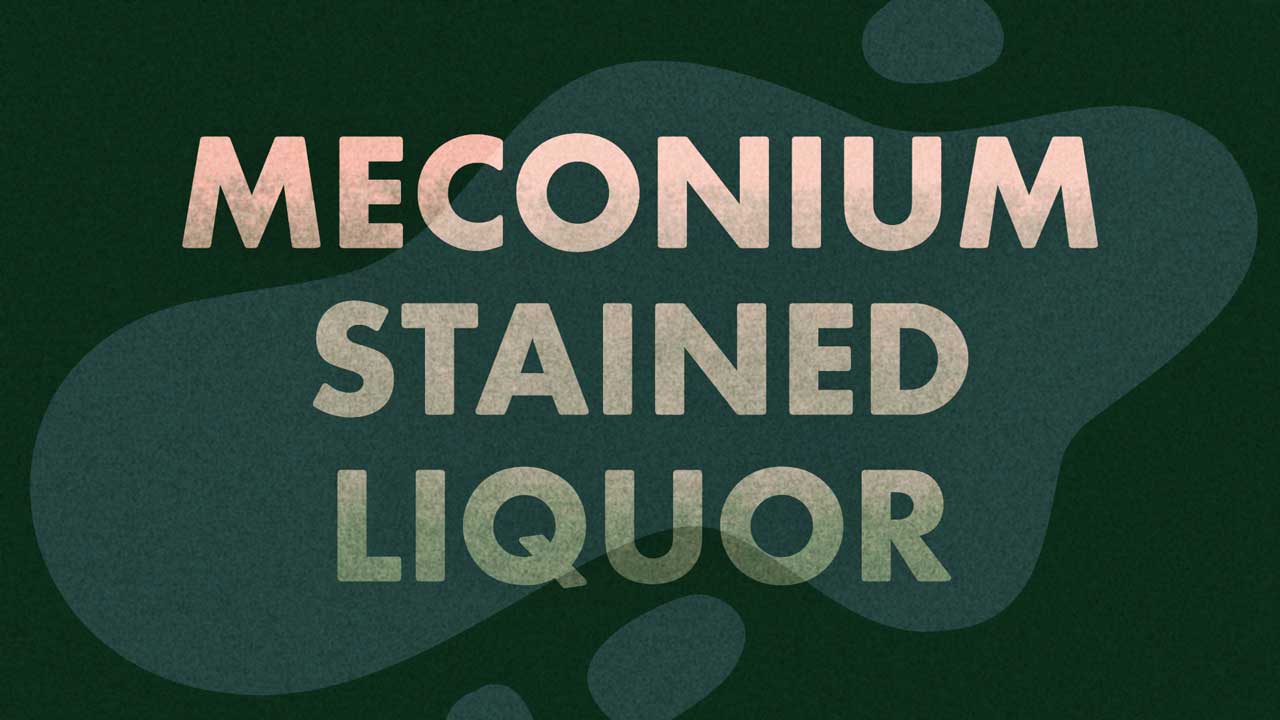The appearance of meconium-stained liquor (MSL) during labour is generally considered to be a sign of hypoxia and a predictor of poor fetal outcome. But is this always true?
Meconium-stained amniotic fluid is present in approximately 12 to 20% of live births. Traditionally, MSL has been considered a sign of fetal distress due to hypoxia. However, it can also simply be a physiological response to a normally maturing gastrointestinal tract, causing no ill effects on the fetus (Skelly et al. 2023).
Why is Meconium Sometimes Passed Before Birth?
Reed (2023) suggests five reasons why the fetus may pass meconium before birth:
- Their digestive system has reached maturity, so the intestine has begun working and moving the meconium out. This is the most common reason.
- Their cord or head is being compressed during labour, causing a vagally mediated gastrointestinal peristalsis.
- Fetal distress resulting in hypoxia. Although the exact relationship between fetal distress and meconium-stained liquor is uncertain, it’s thought that lack of oxygen and intestinal ischaemia relax the anal sphincter and increase gastrointestinal peristalsis, resulting in the passage of meconium.
- The fetus is in a breech position, which can cause compression of the abdomen, and, consequently, meconium to be squeezed out.
- Intrahepatic cholestasis of pregnancy can cause increased movement of fluids through the fetus’s bowel and lead to the passage of thin meconium.
It’s worth pointing out that fetal distress can be present without the presence of meconium, and meconium can be present without fetal distress (Reed 2023).
Is the Presence of Meconium-stained Liquor Always Dangerous?
It’s always important to consider the whole clinical picture before deciding if the presence of meconium is a cause for concern.
Whilst it’s true that the presence of meconium in the amniotic fluid can be an indication of fetal distress, it’s also true that most babies who are born in poor condition do not have meconium-stained liquor and most babies with meconium-stained liquor are born in good condition (Reed 2023).
In a global sense, MSL is still considered to be a marker for adverse perinatal outcomes. Whilst the passage of meconium alone is rarely a sign of significant fetal hypoxia or acidosis, meconium in the presence of an abnormal fetal heart rate (FHR) pattern should always be investigated further.
Risk Factors for Meconium Aspiration Syndrome
Meconium aspiration syndrome (MAS) is a condition that can occur when the infant accidentally inhales meconium during delivery (Geis 2023).
MAS is estimated to occur in 3 to 12% of births where meconium-sained liquor is present (CAHS 2023).
Overall, MAS is known to have a higher incidence with:
- Increase in gestational age
- Low Apgar score at birth
- Abnormal fetal heart rate
- Caesarean birth
- Placental insufficiency.
(CAHS 2023)
The Debate About Intervention
Whilst each hospital will have its own documented policies on the management of meconium-stained liquor, Reed (2023) urges all practitioners to consider the holistic picture and suggests the following practical steps that might help lower the risk of meconium aspiration syndrome:
- Avoid artificial rupture of the membranes (ARM) during labour. If there is meconium present, it will remain well-diluted, and the amniotic fluid will protect the baby from compression during contractions.
- Ensure that the parent knows meconium is a variation and not necessarily a complication. A post-date baby with old meconium is very different from a 38-week baby with thick, fresh meconium.
- Avoid any interventions that are associated with fetal distress, such as ARM, the use of syntocinon/pitocin, or directed pushing.
Safer Care Victoria (2016) also comment on the following areas of uncertainty in clinical practice, suggesting that:
- There is no evidence that management of meconium-stained liquor should be based on the consistency of the meconium
- There is no evidence that techniques used to prevent the infant from gasping after birth are effective in reducing the risk of MAS.
Ongoing Care of Infants Born Through Meconium-stained Liquor
Following birth, infants born through MSL may require ongoing care.
- The infant may require continued resuscitation, depending on their condition
- If the infant develops apnoea or respiratory distress, they will require intubation and tracheal suctioning prior to assisted ventilation
- Once resuscitation is complete, aspiration of the stomach is recommended
- The infant may require admission to special care nursery for observation if:
- There is meconium below the cords
- The infant is experiencing ongoing respiratory distress, or requires oxygen
- There is need for active resuscitation involving CPR or prolonged intermittent positive pressure ventilation (IPPV).
(SCV 2016)
Test Your Knowledge
Question 1 of 3
Which one of the following is not a reason why meconium may be passed before birth?
Topics
References
- Child and Adolescent Health Service 2023, Meconium Aspiration Syndrome, Government of Western Australia, viewed 10 January 2025, https://www.cahs.health.wa.gov.au/-/media/HSPs/CAHS/Documents/Health-Professionals/Neonatology-guidelines/Meconium-Aspiration-Syndrome-MAS.pdf
- Geis, GM 2023, Meconium Aspiration Syndrome, Medscape, viewed 10 January 2025, https://emedicine.medscape.com/article/974110-overview
- Reed, R 2023, ‘The Curse of Meconium Stained Liquor’, MidwifeThinking, viewed 9 January 2025, https://midwifethinking.com/2015/01/14/the-curse-of-meconium-stained-liquor/
- Safer Care Victoria 2016, Meconium Stained Liquor (MSL) Management, Victoria State Government, viewed 10 January 2025, https://www.safercare.vic.gov.au/clinical-guidance/neonatal/meconium-stained-liquor-msl-management
- Skelly, CL, Zulfiqar, H & Sankararaman, S 2023, ‘Meconium’, StatPearls, viewed 9 January 2025, https://www.ncbi.nlm.nih.gov/books/NBK542240/
 New
New 
